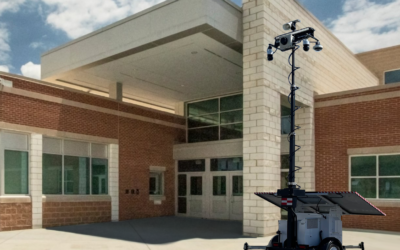24% of business leaders reported an increase in physical security incidents in 2023, and more than half indicated they were more worried about crime than a year ago. Entering 2024, many businesses are fearful that crime will rise, which demonstrates the need for robust physical security systems.
Recognizing emerging trends in the physical security industry in 2024 allows organizations to allocate resources effectively to defend against threats such as security breaches, unauthorized access, and cyber-physical system attacks.
Emerging Trends in Physical Security
Throughout the next year, emerging trends will continue to reshape the physical security industry and influence the response to both physical and cyber threats.
Move Towards Zero-Trust Frameworks
Zero-trust frameworks are already prevalent in the cybersecurity sector, and their implementation is considered a top priority for most businesses.
Based on the notion of never trusting and always verifying, the zero-trust model requires all users to be continuously authorized and validated when accessing new applications, data, and resources. This framework has proven to reduce the risk of data breaches and allow businesses to protect their assets from outsider access.
As the threat landscape evolves, the implementation of zero-trust frameworks has extended across the physical security sector.
Many attacks on organizations rely on physical access to infiltrate IT systems and networks. Through social engineering techniques, copied ID badges, and invalid credentials, attackers can exploit physical access points to breach an organization’s perimeter. Once inside, they often have unrestricted access to server rooms, offices, and computers to proceed with a cyberattack, such as stealing valuable information through a USB or downloading malware onto an organization’s system.
Many organizations are moving towards zero-trust frameworks for their physical security needs in response to the increasing threat of cyber-physical system security breaches. Smart badges are a key example of a physical security measure that implements the zero-trust model to prevent unauthorized access to an organization’s facility.
Through these badges, all employees and visitors must continuously prove their identity and will only have access to the resources necessary for their roles. Smart badges can also be altered to instantly change each user’s permissions.
For example, if a badge is lost, all of its permissions can be immediately restricted, preventing unauthorized access until the badge is recovered or replaced. Similarly, as employees join new projects, their access permissions can be altered without any delays, enhancing the organization’s operational efficiency.
The zero-trust model underlines the importance of refining physical security measures rather than relying on cybersecurity systems. While cybersecurity has rightfully received significant attention from organizations, even the most robust cybersecurity measures can be circumvented if physical access points are compromised. Zero-trust frameworks acknowledge these risks and highlight the need for continuous verification in physical security practices.
Focus on Public Trust in Physical Security
As confidence in law enforcement has considerably dropped in recent years, security guards have emerged as key figures in fostering trust and ensuring a sense of safety among communities.
After a three-decade peak in the early 2000s, public trust in the US government has plummeted. Studies have shown that less than 15% of Americans trust the federal government to do the right thing “most of the time,” while faith in law enforcement has experienced a similar decline.
Entering 2024, trust in police continues on a downward trend. With distrust in law enforcement, community members may be less likely to cooperate with police investigations, report crimes, or seek assistance when needed, leading to widespread feelings of fear and vulnerability.
The United Nations Sustainable Development Goals Report observed that “feeling unsafe in public can fundamentally erode one’s sense of wellbeing and reduce trust and community engagement, becoming an obstacle to development.” When the public is hesitant to contact and cooperate with police, the presence of trusted physical security becomes paramount.
Physical security services can maintain a safe environment and build trust with the public by engaging in rigorous staff training to ensure personnel perform their duties with professionalism, competence, and adherence to ethical standards.
Prioritizing transparent communication and engagement with community members will further enhance trust and collaboration, subsequently increasing the effectiveness of physical security measures.
Modernization of Physical Security
Advancements and breakthroughs in technology play a key role in the implementation and execution of physical security measures. Throughout 2024, physical security is predicted to become increasingly modernized through an integration of cybersecurity measures.
Convergence with Cybersecurity
Changes in the threat landscape require businesses to take a unified approach to physical and cyber security rather than managing both components separately. The adoption of cyber security has been accelerating over the last decade, and, in response, attackers are taking new approaches to infiltrate systems to steal sensitive data and disrupt business operations.
The rise in remote working has also presented new business challenges and can create larger vulnerability gaps. As a result, many organizations are focusing on fostering collaboration between physical and IT security teams to ensure a synergetic approach to threat identification, mitigation, and management.
Challenges
Managing converged security solutions can be a complex process for businesses, as many considerations need to be taken.
For example, personnel must receive adequate training to understand physical and cyber security practices to collaborate effectively. This need for additional training may be resource-intensive and time-consuming.
Organizations that are combining physical and IT security teams, which are traditionally separate departments, may also encounter resistance that arises from conflicting priorities. Individuals in each department may also perceive the integration as a threat to their existing roles and organizational authority. Due to this, organizations must thoughtfully plan and execute the convergence process, considering the unique needs and concerns of each department.
Benefits
Although physical and cyber security convergence does present challenges, they are vastly outweighed by the benefits, which include:
- Additional efficiency – Connecting physical and cyber security approaches removes the possibility of duplicated efforts, raising overall productivity and efficiency.
- Sustainable strategies – The alignment of physical and cyber security allows the creation of resilient defense and risk management systems that can adapt to emerging threats and evolving organizational needs.
- Enhanced threat detection – As physical security and IT teams collaborate, organizations can ensure faster threat detection and responses, minimizing the impact of security incidents or data breaches.
- Unified view of security – Convergence provides a holistic view of an organization’s entire security efforts, making it easier to identify vulnerabilities and areas for improvement.
- Alignment of common goals – By breaking down the barriers between physical and cyber security, organizations can promote collaboration and enhance decision-making to establish more effective security solutions.
AI integration
2022 is widely considered a turning point for artificial intelligence, as many AI companies experienced numerous breakthroughs that accelerated their worldwide adoption.
Moving into 2024, AI is not only widespread among consumers but has also been integrated into various industries, including the physical security sector. In a recent survey, 33% of respondents claimed to have plans to add AI applications in their physical service environment in 2024.
Particularly in surveillance, AI can directly enhance the effectiveness of physical security measures. When video footage needs to be analyzed, AI can aid security personnel in the identification process and even pinpoint anomalies that human operators might miss. AI also has real-time analysis capabilities to identify and report incidents, allowing the rapid response of security guards.
In its current state, AI is a valuable tool that can optimize the efficiency of existing security measures and even reduce the costs associated with physical security services.
Virtual Reality Training for Security Personnel
Virtual reality (VR) has been used for law enforcement training since the 1990s. More recently, security services have adopted this technology to enhance the training of their security guards.
VR offers a safe and controlled environment for security personnel to practice their response skills and enhance their situational awareness. Through high-quality graphics and AI-driven scenarios, VR provides an immersive and scalable training environment that can be easily adjusted based on an individual’s performance. This is also a cost-effective option for security service providers since guards can be trained on-site, even with limited space, through the use of a VR system.
VR systems use has surged in recent years, becoming a widely available and highly accessible form of training for security professionals. The integration of VR is contributing to a technological-focused and modern approach to physical security.
Other Factors Influencing Physical Security Trends
Cultural and physical shifts in the world throughout 2024 and in the following years present both new obstacles and opportunities for physical security services.
Growing Importance of Privacy Regulations
As data collection tools become more sophisticated, data privacy has come into focus across the US. Companies now collect data in various forms, and it is their responsibility to protect this data from exposure. However, confidence in companies regarding the use of personal data has been declining.
In a 2023 study on consent, only 14% of respondents believed that companies can be trusted to use their personal data with their best interests in mind. High-profile data breaches, regulatory violations, and data misuse incidents are key contributors to this lack of trust.
Using Physical Security to Protect User Data
The GDPR, the EU equivalent to the CCPA (California Consumer Privacy Act), highlights that physical security is essential for preventing “accidental or unlawful destruction, loss, alteration, unauthorized disclosure of, or access to personal data transmitted, stored, or otherwise processed.”
Despite sensitive users’ data being stored online, organizations must use physical safeguards and consider where physical barriers are needed throughout their facilities. In open-office floor plans, employee computers are not shielded, which can potentially lead to data breaches. Likewise, shared printers, copiers, and fax machines not in protected areas can result in unauthorized access to sensitive data.
In organizations, particularly ones where closed-office spaces are not feasible, physical security measures can deter and mitigate these risks.
For example, surveillance cameras can be installed to monitor employee workstations and capture evidence of security breaches, allowing organizations to take swift action. Similarly, security guards can conduct routine patrols of sensitive areas, ensuring that only authorized employees have access to certain areas and equipment.
However, physical security systems must be integrated with discretion, as overly intrusive approaches can infringe on employee privacy, leading to discomfort and limited cooperation.
For instance, cameras in break areas are unnecessary for protecting sensitive user data and would cause unease among employees.
By thoughtfully integrating physical security measures, organizations in the US can ensure compliance with CCPA regulations without infringing on employee privacy. The aforementioned approaches can enhance user trust and confidence in the handling of their data. They can also be used as a strategic advantage by organizations to improve their brand value and reputation.
Environmental Risks
Emergency preparedness plans that incorporate environmental risks are continuously gaining momentum among businesses. Organizations are revising their security strategies to account for natural disasters and other environmental incidents, which are on the rise across the United States.
Floods, fires, and extreme weather events are becoming more frequent and severe due to the world’s changing climate. These natural risks can result in interruptions to organizations, including power outages, property damage, supply chain disruptions, and potential employee or customer harm.
Certain security measures can be employed to enhance an organization’s resilience and responsiveness to these events. Surveillance systems equipped with environmental sensors can monitor for signs of impending environmental hazards. These sensors can detect changes in temperature, humidity, and air quality to provide early warnings to businesses, allowing for greater preparedness to mitigate potential damage.
Strict control access measures, such as smart badges with integrated zero-trust architecture, can prevent unauthorized access to sensitive areas throughout a facility, even during an emergency situation where security personnel are occupied with evacuation or similar procedures.
Reliable communication systems must also be implemented to ensure seamless coordination between security personnel, employees, and emergency responders during a severe environmental event.
Overall, organizations must recognize and prepare for the impact of natural disasters and environmental incidents to help ensure the protection of assets and the safety of employees.
Similarly, security personnel should be adequately trained to react appropriately to environmental emergencies.
By conducting regular drills, both organizations and security services can test their emergency preparedness and identify areas for improvement in their physical security approaches.
Future Outlook
Physical security will continue to transform throughout 2024 as security services and organizations adopt advanced technology and respond to rising challenges in the sector.
Predictions for Physical Security Technology
Beyond 2024, we can expect further unification between physical and cybersecurity measures. Cyber threats will likely become increasingly sophisticated in the following years, prompting more organizations to implement advanced and modern security solutions.
Organizations that currently integrate cyber security measures in their physical security operations may see a positive impact and be further inclined to utilize technologies to tackle security concerns.
Furthermore, with the rise of cyber-physical system security breaches, a new focus on the need for comprehensive physical security solutions may occur. As technology advances, the need for robust physical security systems such as access control, surveillance, and patrols becomes increasingly vital.
Before organizations consider adopting new technologies for their operation, they must consider which physical protection they have in place since high-value tech is a prime target for theft.
Overall, the evolution and adoption of physical security are directly linked to the state of technology. As digital defenses become more sophisticated, attackers may resort to traditional intrusion methods, underlining the need for carefully implemented physical security systems.
Challenges
Despite a promising future, physical security is expected to face numerous challenges in the coming years.
For example, rising costs across the US may impact the rate of implementation of physical security services. As executives aim to maximize profits, shortcuts may lead to a decreased focus on physical security measures.
Additionally, after the COVID-19 pandemic, organizations are continuing to move towards remote and hybrid working models. These new working arrangements can prove to be challenging for physical security teams, as the number of employees on-premises can be unpredictable and constantly changing.
These challenges may cause instability and uncertainty in the physical security sector but may also translate to new opportunities for security services and businesses alike.
Conclusion
Overall, physical security is experiencing a paradigm shift in 2024, which is largely due to shifting priorities for organizations.
In previous years, there has been a greater focus on developing and refining cyber security measures to combat increasing cyber-attacks. However, as attackers resort to traditional forms of intrusion, such as social engineering and physical breaches, organizations are pushed to reshuffle their priorities.
Physical solutions, such as surveillance cameras, security patrols, and access control, are crucial in protecting company assets and sensitive user data. But, in our technological-focused society, their convergence with cyber security systems is becoming more common. Zero-trust access control, AI surveillance, and VR training are all examples of the implementation of cybersecurity approaches in traditional security systems.
As we continue through 2024, we can expect further unification between physical and cybersecurity. Organizations that have already adopted this approach may reveal its positive impact, which will prompt widespread integration across various industries.
Despite a regained significance, physical security will still face numerous challenges. Budget cuts, employee resistance, and increasingly advanced attacks may impact the incorporation and effectiveness of physical security measures. Organizations must pay attention to evolving threats to appropriately position and future-proof their security efforts.
When properly integrated and utilized, physical security is integral in protecting assets, ensuring public trust, and promoting a sense of safety nationwide.






